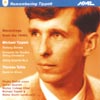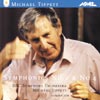Tippett Recordings from the 1940s
Valuable early Tippett recordings and Sir Michael conducting his symphonies
View record and artist detailsRecord and Artist Details
Composer or Director: Michael Tippett, Thomas Tallis
Label: NMC
Magazine Review Date: 2/2005
Media Format: CD or Download
Media Runtime: 75
Mastering:
Mono
ADD
Catalogue Number: NMCD103

Tracks:
| Composition | Artist Credit |
|---|---|
| Sonata for Piano No. 1 |
Michael Tippett, Composer
Michael Tippett, Composer Phyllis Sellick, Piano |
| Concerto for Double String Orchestra |
Michael Tippett, Composer
(Anonymous) Orchestra Michael Tippett, Composer Walter Goehr, Conductor |
| String Quartet No. 2 |
Michael Tippett, Composer
Michael Tippett, Composer Zorian Qt |
| Spem in alium |
Thomas Tallis, Composer
Michael Tippett, Conductor Morley College Choir Thomas Tallis, Composer |
Composer or Director: Michael Tippett
Genre:
Orchestral
Label: NMC
Magazine Review Date: 2/2005
Media Format: CD or Download
Media Runtime: 73
Mastering:
Stereo
DDD
Catalogue Number: NMCD104

Tracks:
| Composition | Artist Credit |
|---|---|
| Symphony No. 2 |
Michael Tippett, Composer
BBC Symphony Orchestra Michael Tippett, Conductor Michael Tippett, Composer |
| Symphony No. 4 |
Michael Tippett, Composer
BBC Symphony Orchestra Michael Tippett, Conductor Michael Tippett, Composer |
Author: Arnold Whittall
‘Remembering Tippett’ easily counters the claim that early performers, faced with the rhythmic and textural complexity of his scores, betrayed insecurity and incomprehension. In the Fantasy Sonata (the original version of what became ‘Sonata No 1’) Phyllis Sellick conveys a genuine sense of joy at the music’s quirky exuberance, and the rather light bass imposed by the recording strengthens that spirit of delight. The sound is also extremely confined in the Concerto for Double String Orchestra and the String Quartet No 2, but there’s a case for saying that the drama of this music’s contrapuntal interplay is actually enhanced when the wide-open spaces of stereo placement are not available, and neither of these accounts lacks richness of texture or vivacity of interpretation. The sense of apotheosis Walter Goehr achieves in the Concerto’s marvellous finale, and the needle-sharp reactions of the Zorian team in the Second Quartet’s extremely tricky Scherzo as are fine as anything you’ll hear in later, sonically more polished recordings.
The performance of Tallis’s 40-part motet commemorates Tippett’s work as Director of Music at Morley College, and although, as Anthony Burton’s extensive documentary notes explain, Tippett was never the most technically proficient of conductors, the rich, rolling sound – more 19th than 16th century in character – is remarkable. The Morley amateurs had some professional stiffening for the occasion, and presumably this large choral body was kept on track by being given pitches before each 78rpm side was recorded separately.
Martin Cotton’s fascinating report on the 1993 recordings of the Second and Fourth Symphonies reveals how close the project came to collapse, and the result is not ideal in either interpretative or recording terms. In the end, however, Tippett’s down-to-earth good humour, coupled with the orchestra’s determination to do their best by this well-loved grand old man of British music, ensured that the recordings were completed in the three days allocated: and although these versions don’t displace Richard Hickox’s estimable recordings (Chandos 11/93, 10/94) of these works – part of his complete Tippett cycle – they are certainly well worth hearing.
Perhaps the Fourth Symphony simply wasn’t given enough time to gel. But the Ivesian associations of its collage-like design are clear, and the moments when the brass burst out with their exuberant fanfares and roulades have a splendid panache. The Second has a better balance between singing melody and stamping dance, and although the scherzo – taxing for the most expert conductor – sounds a bit tentative, the overall effect is bracing, heroic, radiating that supremely positive spirit which was Tippett’s special gift to 20th-century music.
Explore the world’s largest classical music catalogue on Apple Music Classical.
Included with an Apple Music subscription. Download now.

Gramophone Digital Club
- Digital Edition
- Digital Archive
- Reviews Database
- Events & Offers
From £9.20 / month
Subscribe
Gramophone Club
- Print Edition
- Digital Edition
- Digital Archive
- Reviews Database
- Events & Offers
From £11.45 / month
Subscribe
If you are a library, university or other organisation that would be interested in an institutional subscription to Gramophone please click here for further information.






